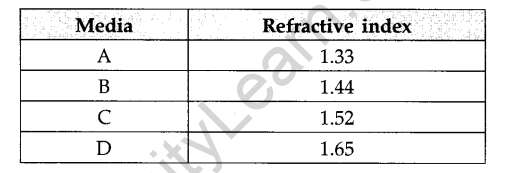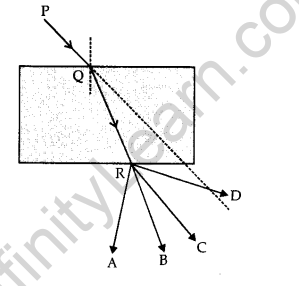SECTION-A
1.Write the number of vertical columns in the modern periodic table. What are these columns called ?
2.No two individuals are absolutely alike in population. Why ?
3.Mention one reason of discontentment among the people who have been displaced by building dams.
4.Write full forms of DNA. Where is it located ?
5.What is the importance of DNA copying in reproduction ? . [HOTS]
6.What damage is caused to forests by the following:
(a)Building rest houses for tourist in national parks.
(b)Grazing domestic animals in national parks. [HOTS]
7.Explain why is it difficult to wash clothes with soap when water is hard. How do detergents help in overcoming this problem ?
8.Two compounds ‘A’ and ‘B’ have the molecular formula C3H8 and C3Hg, respectively. Which one of the two is most likely to show addition reactions ? Justify your answer. Explain with the help of a chemical equation, how an addition reaction is useful in vegetable ghee industry.
9.Explain why carbon forms compounds mainly by covalent bonds. Explain in brief two main reasons for carbon forming a large number of compounds. Why does carbon form strong bonds with most other elements ?
10.(a)State any three physical properties of carbon compounds.
(b)Carbon is a versatile element. Justify this statement.
11.Write two examples each of sexually transmitted diseases caused by (i) virus, (ii) bacteria. Explain how the transmission of such diseases can be prevented.
12.(a)Name the following:
(i)Thread like non-reproductive structures present in
(ii)’Blobs’ that develop at the tips of the non-reproductive threads in
(b)Explain the structure and the function of the structures released from the ‘blobs’ in
13.What is speciation ? List four factors responsible for speciation.
14.Homologous organs are different form analogous organs.
(a)Mention the two basic characteristics that decide about analogy and homology between the two organs.
(b)On what basis is the classification of organisms into prokaryotic and eukaryotic done ?
15.Draw a ray diagram to show that path of the refracted ray in each of the following cases :
A ray of light incident on a concave lens is
(i)passing through its optical centre.
(ii)parallel to its principal axis.
(iii)directed towards its principal focus.
16.The image of candle flame placed at a distance of 40cm from a spherical lens is formed on a screen placed on the other side of the lens at a distance of 40 cm from the lens. Identify the types of lens and write its focal length. What will be the nature of the image formed if the candle flame is shifted 25cm towards the lens ? Draw ray diagram to justify.
17.An old man cannot see objects closer than 1 m from the eye clearly. Name the defect of vision he is suffering from. How can it be corrected ? Draw ray diagram for the (i) defect of vision and also (ii) for its correction
18.”Vision” is one of the wonderful gifts given to us by God. But most of the people never take care of their eyes. Care for eyes should be taken, suggest some methods for proper eye care.
19.What is the difference between the chemical composition of soaps and detergents ? State in brief the action of soaps in removing an oily spot from a shirt. Why are soaps not considered suitable for washing where water is hard ?
20.(i) Identify the process depicted in the picture given below :

(a)Name the organism that divides by the above process.
(b)Compare the above process with multiple fission.
(c)State the type of reproduction in the above process and define it.
21.Different organisms reproduce by different methods suitable to their body designs.
(a)Justify the above statement using examples of three different organisms which reproduce by different methods of asexual reproduction.
(b)Differentiate between sexual and asexual modes of reproduction.
22.(a) A person cannot read newspaper placed nearer than 50 cm from his eyes. Name the defect of vision he is suffering from. Draw a ray diagram to illustrate this defect. List its two possible causes. Draw a ray diagram to show how this defect may be corrected using a lens of appropriate focal length.
(b) We see advertisements for eye donation on television or in newspapers. Write the importance of such advertisements.
23. Define the term absolute refractive index. The absolute refractive index of diamond is 2.42. What is the meaning of this statement ? Refractive indices of media A, B, C and D are given below :

In which of these four media is the speed of light (i) minimum and (ii) maximum ?
Find the refractive index of medium C with respect to medium B.
24.An object of height 6 cm is placed perpendicular to the principal axis of a concave lens of focal length 5 cm. Use lens formula to determine the position, size and nature of the image if the distance of the object from the lens is 10 cm.
SECTION-B
25.In order to study saponification reaction, we first prepare 20% solution of sodium hydroxide. If we record the temperature of this solution just after adding sodium hydroxide flakes to water and also test its nature using litmus, it may be concluded that the process of making this solution is :
(A)exothermic and the solution is alkaline (B) endothermic and the solution is alkaline (C) endothermic and the solution is acidic (D) exothermic and the solution is acidic
26.While studying saponification reaction for the preparation of soap, a teacher suggested to a student to add a small quantity of common salt to the reaction mixture. The function of common salt in this reaction is to:
(A) reduce the alkalinity of the soap (B) reduce the acidity of the soap
(C) enhance the cleansing capacity of soap (D) favour precipitation of soap
27.Read the following statements :
I.When a red litmus paper is dipped into reaction mixture of a saponification reaction, it turns blue and the reaction is exothermic.
II.When a blue litmus paper is dipped into reaction mixture of a saponification reaction, its colour does not change and the reaction is exothermic.
III.When a red litmus paper is dipped into reaction mixture of a saponification reaction, its colour does not change and the reaction is endothermic. .
IV.When a blue litmus paper is dipped into reaction mixture of a saponification reaction, its colour does not change and the reaction is endothermic.
Which of the above statements are correct ?
(A) I and II (B) II and III
(C)III and IV (D) I and IV
28.In finding the image of a distant object of a tree by concave mirror, you are required to hold a vertical plane white board at:
(A) Centre of curvature (B) Pole
(C) Focus (D) Behind mirror
29.Four students A, B, C, D were asked to take three sets of observations for tracing the path of a ray of light through a glass slab. The choice of different angles of incidence made by them were :
(A) 10°, 15°, 20° (B) 15°, 20°, 25°
(C) 30°, 45°, 60° (D) 70°, 75°, 80° .
The student who would likely to get best result is :
(A) Student A (B) Student B
(C) Student C (D) Student D
30.While performing the experiment to trace the path of a ray of light through a glass slab, four students A, B, C, D have drawn emergent ray for the same incident ray PQ as RA, RB, RC and RD respectively:

Which of the students has drawn emergent ray correctly ?
(A)A
(B)B
(C)C
(D)D
31.During budding in yeast, the parent cell divides by the process :
(A)Cytoplasm and nucleus divides at the same time.
(B)The nucleus first divides and then cytoplasm.
(C)The cytoplasm first divides and then nucleus.
(D)The cytoplasm and nucleus do not divide.
32.A student observed a cell and another cell of comparatively smaller size attached to the first cell. This slide could be that of :
(A) Yeast with bud (B) Amoeba with bud
(C) Two daughter cells of Amoeba (D) Two buds of yeast.
33.Out of the four slides I, II, III, and IV whose details are shown below, which one should be focused under the microscope for showing budding in yeast ?

34.Differentiate between analogous and homologous organs.
35.Explain why it is difficult to wash clothes with soap when water is hard. How do detergents help in overcoming this problem ?
36.At what positions of the object in front of convex lens, do we get real and virtual images ?


